The Samsung PM981 SSD Review (512GB, 1TB): Next Generation Controller And 3D NAND
by Billy Tallis on November 30, 2017 9:02 AM ESTAnandTech Storage Bench - Heavy
Our Heavy storage benchmark is proportionally more write-heavy than The Destroyer, but much shorter overall. The total writes in the Heavy test aren't enough to fill the drive, so performance never drops down to steady state. This test is far more representative of a power user's day to day usage, and is heavily influenced by the drive's peak performance. The Heavy workload test details can be found here. This test is run twice, once on a freshly erased drive and once after filling the drive with sequential writes.
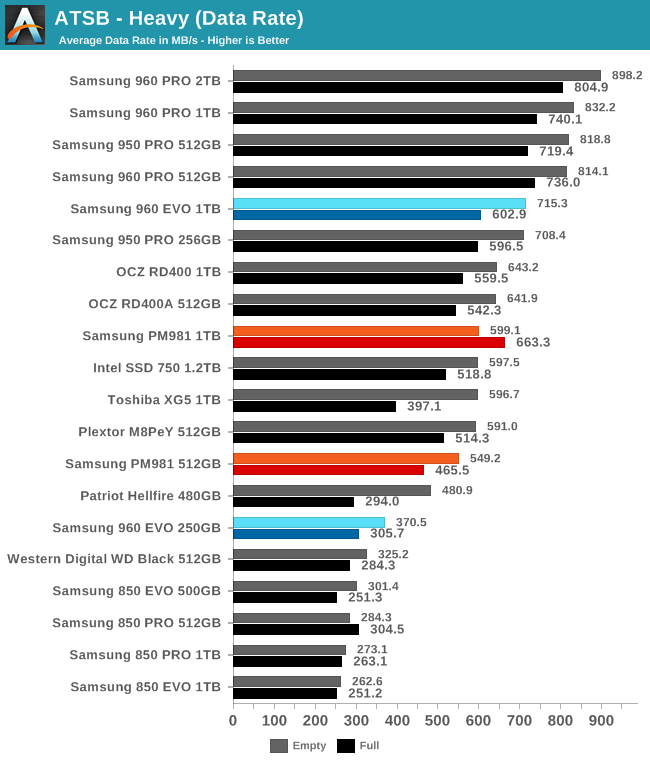
On the Heavy test, the average data rates of the 512GB Samsung PM981 again lag slightly behind most MLC-based NVMe drives but are clearly ahead of the competitors' TLC drives. The 1TB PM981 is behaving a bit oddly with slower than expected performance after a secure erase, but great performance when filled.
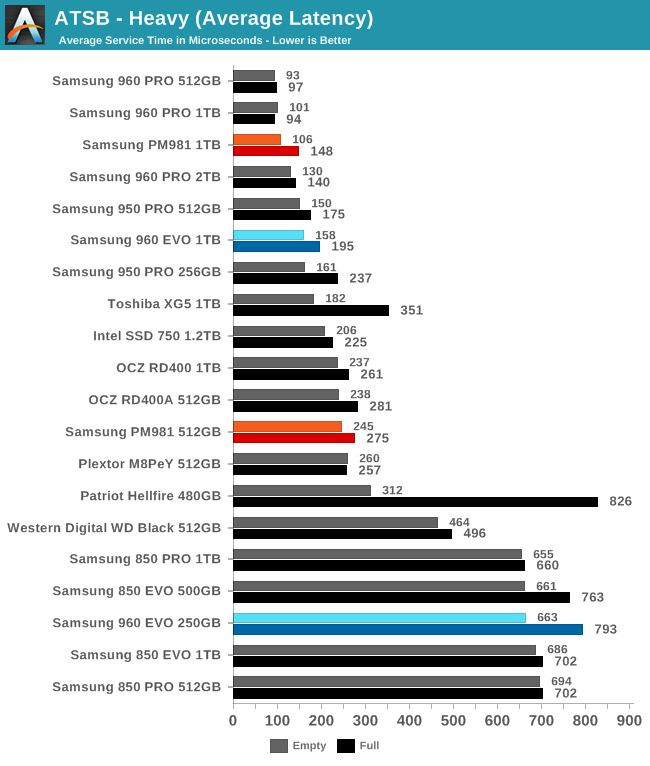
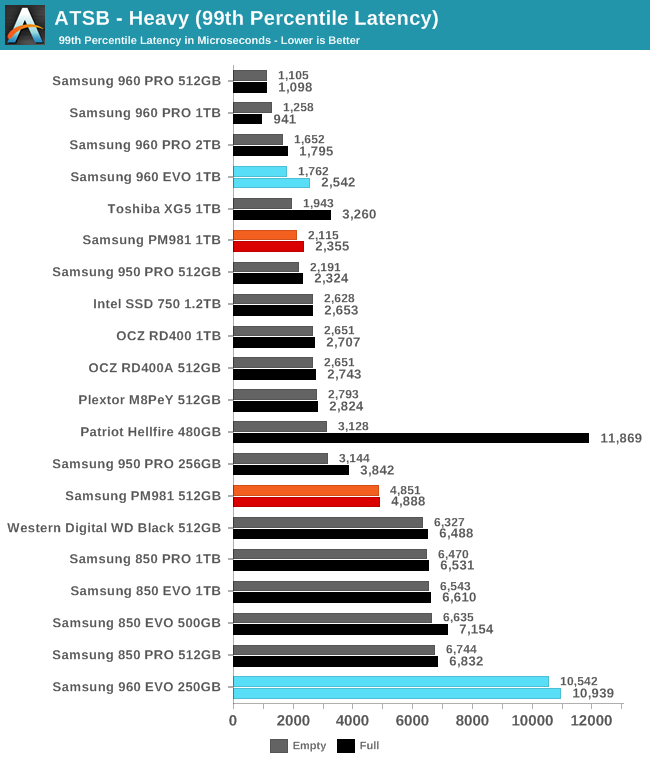
The average latency of the 1TB PM981 is a significant improvement over the 1TB 960 EVO, while the 512GB PM981 doesn't stand out from the other 512GB drives. The 99th percentile latencies aren't particularly good, and the 512GB PM981 scores worse than almost all the other PCIe SSDs of that size.

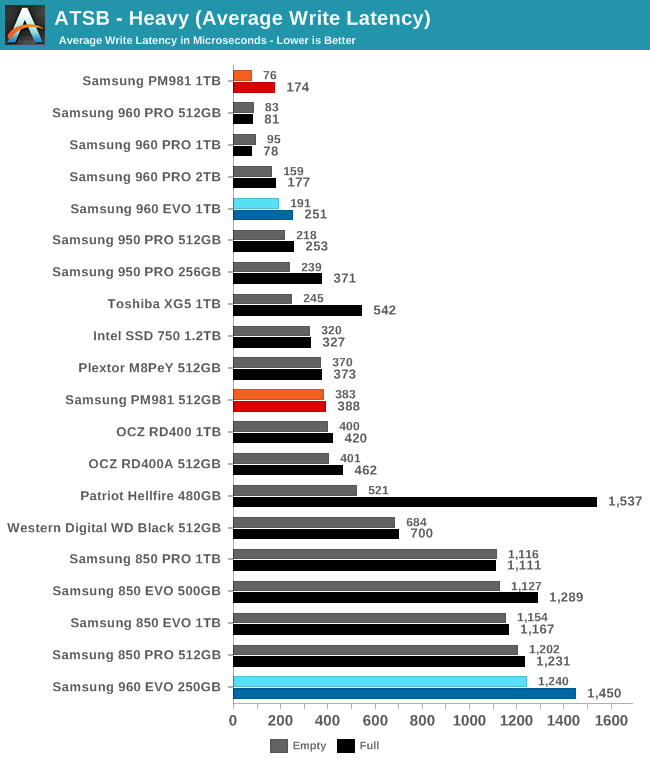
The average write latency of the 1TB PM981 is excellent especially when the test is run on an empty drive. Average read latencies for both drives are decent but aren't a big improvement over their predecessors.
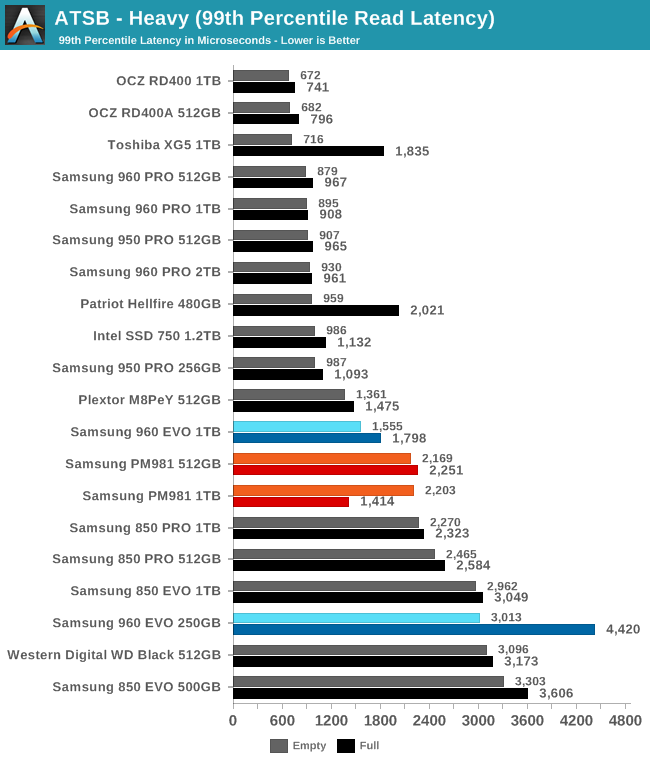
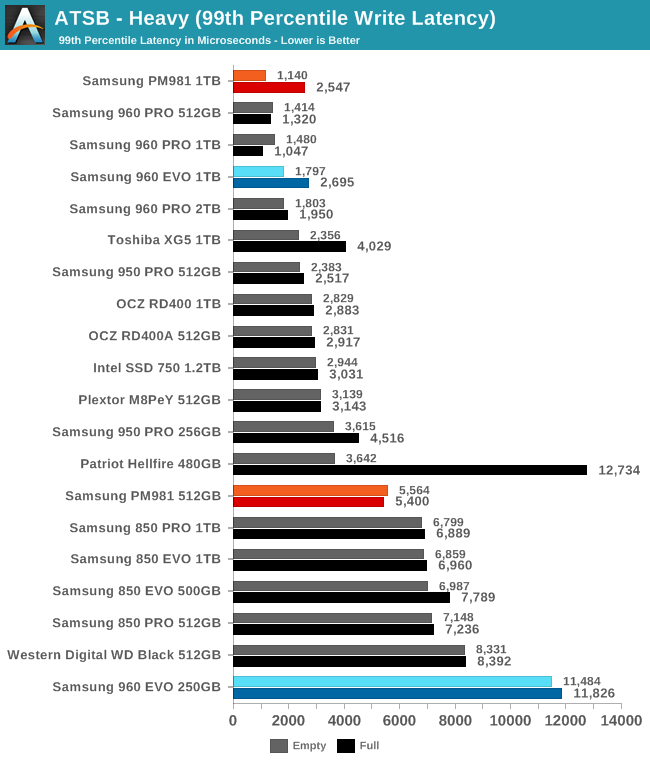
The 99th percentile read latencies are one of the few ATSB scores where the TLC-based nature of the PM981 shines through. Many MLC-based SSDs are much better at keeping read latency under control, and the TLC-based Toshiba XG5 also scores much better than the PM981 here. The 99th percentile write latency of the 1TB PM981 is pretty good, following suit to the average write latency, while the 512GB model could use some improvement.










53 Comments
View All Comments
tsk2k - Thursday, November 30, 2017 - link
It's all about that 3D-Xpoint nowadays.rsandru - Thursday, November 30, 2017 - link
Speaking of which, can we have the Optane 900p data points back in?boeush - Thursday, November 30, 2017 - link
Hmm, yeah - all about 1 TB 3D XPoint - how much would that cost, again, and what's the retail availability of the M2 form-factor?ddriver - Thursday, November 30, 2017 - link
Unfortunate after so many years of complete domination samsung is not even trying anymore. It will be TLC all over in order to squeeze out every cent worth of profit from that advantage.Spunjji - Thursday, November 30, 2017 - link
"...the PM981 has caught up to or surpassed the MLC-based 96x drives on many tests, setting new records not just for TLC-based drives but for client SSDs as a whole."Right; they're clearly not trying at all. :|
mapesdhs - Thursday, November 30, 2017 - link
"...in order to squeeze out every cent worth of profit from that advantage."That's called business. If rivals don't like it, they should make something better and bring it to market. I might not like how Samsung has managed its pricing, etc., but if I were them, then based on fiduciary duty to shareholders I would do exactly the same thing.
ddriver - Thursday, November 30, 2017 - link
They are not, but it requires north of a simpleton's way of looking at it to see it. Because they could have kept MLC and offered a significant boost in performance thought the entire drive.And the claim that using TLC it catches up on MLC drives is just nonsense. There is no engineering miracle here. There is simple caching at play, the drive doesn't touch TLC for the duration of AT's flimsy test suite. Once the drive runs out of cache performance quickly gets abysmal - about 750 mb/s once it gets to the point of using TLC directly. Not to mention the reduced endurance.
Granted most casual consumers won't be doing anything as data intensive, but many prosumers will, which means that current consumer grade drives are no longer adequate for prosumer applications, which wasn't the case with the previous generation, indicating that samsung is indeed taking a step back.
And things are not looking too well in the more affordable enterprise range neither, its lousy with TLC as well. Meaning that samsungs devolution now forces prosumers to shop for the much more expensive high-end enterprise storage solutions.
I don't mind TLC. What I mind is depriving the market of MLC. I didn't mind paying the MLC premium for the 960 PRO over the EVO. It was a good deal. I mind that they are taking that deal away from the market. And if you had 2 properly working brain cells you'd mind that too.
MFinn3333 - Thursday, November 30, 2017 - link
"There is simple caching at play, the drive doesn't touch TLC for the duration of AT's flimsy test suite."What? Here is the destroyer benchmark's description...
Total GB Read: 1583.02 GB
Total GB Written: 875.62 GB
Total IO Operations: 49.8 million
Queue depth is 50% 1 depth.
What is your definition of flimsy?
mkaibear - Friday, December 1, 2017 - link
This is deedee, his definition of "flimsy" is "if there is any possible way in which I can be right, then I meant that".ddrіver - Thursday, November 30, 2017 - link
Exactly. The products are better because time passes on and technology advances, not because they are actually struggling to make them better. Profit is their number one concern performance just happens to increase from time to time...